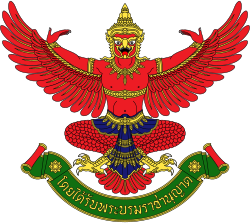| |
|---|---|
 | |
| Versions | |
 Variant with broader wings (displayed by a firm bearing a Royal warrant) | |
| Armiger | Vajiralongkorn (Rama X), King of Thailand |
| Adopted | Officially in 1911, replacing the coat of arms of Siam from 1873. Originally adopted during the Ayutthaya period. |
| Shield | A Garuda gules with wings displayed and elevated armed and crowned or, clothed or and azure. |
| Motto | สพฺเพสํ สงฺฆภูตานํ สามคฺคี วุฑฺฒิ สาธิกา" (Sabbesaṃ saṅghabhūtānaṃ sāmaggī vuḍḍhi sādhikā) (The unity of a people come together as a party shall be a guarantor of prosperity) |
| Use | Used by the government of Thailand on all official documents, is on the Royal Standard of Thailand and is used by The Monarchy of Thailand |
The national emblem of Thailand (Thai: ตราแผ่นดินของไทย) is called the พระครุฑพ่าห์ (RTGS transcription: Phra Khrut Pha; "Garuda as the vehicle" (of Vishnu)). The Garuda was officially adopted as the national emblem by Vajiravudh (Rama VI) in 1911. However, the mythical creature had been used as a symbol of royalty in Thailand for centuries. The Garuda is depicted on seals, which are used by the King and the Government of Thailand to authenticate official documents and as its primary emblem.
The Garuda is a mythological beast of the Hindu and Buddhist tradition. According to Hindu mythology, the Garuda is the vahana (vehicle) of the god Vishnu (Narayana). The ancient kings of Thailand believed in divine kingship, and considered themselves the incarnation of the god Narayana. Thus, the Garuda came to symbolise the divine power and authority of the king.
The Garuda also features in the national emblem of Indonesia and the emblem of the city of Ulaanbaatar.